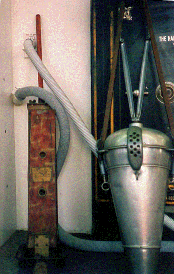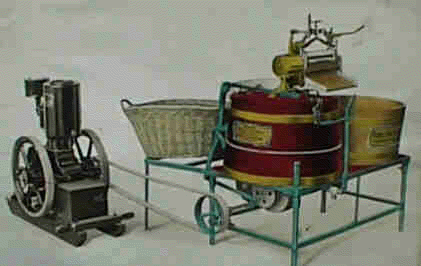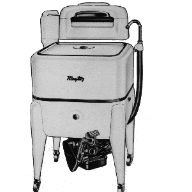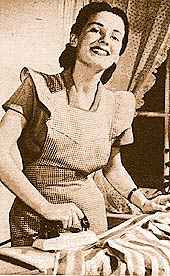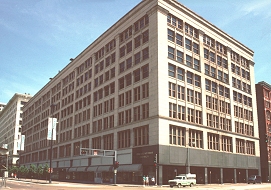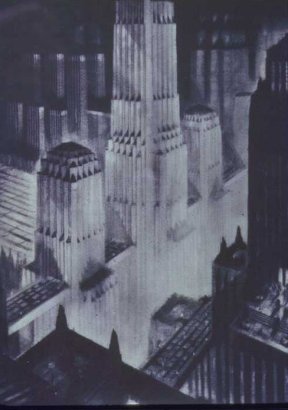By the early 20th century engineering was triumphant--Americans looked to rationality and efficiency to make life better. More, faster, better was the theme of the time. But questions began to be raised. Cowan ch. 8 is important for its discussion of the impact of technological change on the experience of work.
Agriculture:
:
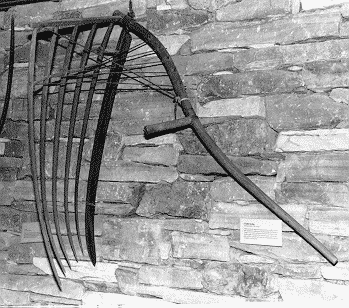
Scythe with cradle
Labor involved in growing 100 bushels of wheat
- 1830 250-300 hours by hand
- 1890 40-50 hours by horse-drawn machine
- 1930 15-20 hours with a tractor
- 1975 3-4 hours with large tractors & combines
1837 John Deere produced a wrought iron plow with steel cutting edge for sticky prairie soil--his factory produced about 1000 in 1846, about 10,000 in 1857. Harrows, grain drills, cultivators, and mechanical threshers (John and Hiram Pitts, 1837) come into use in 1840s
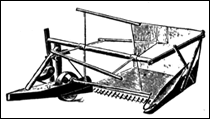
McCormick Reaper
- McCormick didn't have the most uniform or satisfactory product but he moved his factory from Virginia to Chicago to be nearer the demand while Hussey stayed in Baltimore.
- McCormick succeeded by advertising and demonstrations, and by developing exclusive dealerships and selling machines on credit.
- Manufactured by regional franchises until 1851, at which point his production was 1000 per year. Even his steam-powered plan in Chicago in 1850 depended on skilled workers, not special-purpose machines.
- Annual new model made manufacturing innovations difficult and meant replacement parts were an incredible headache--this wasn't a conscious marketing strategy but a combination of improvements and meeting the expectations of farmers.
- Even in the 1870s, factory manager Leander McCormick did not want to expand production and was notably unknowledgeable about machine tools--ordered things that did not exist and asked for parts that were not normally supplied (Chicago too far from New England, for one thing).
- Only introduced mass production techniques in 1880, when Cyrus kicked out Leander and hired Lewis Wilkinson, who had worked at both the Colt Armory and the Wilson Sewing Machine company. Production increased fivefold by 1902.
- labor shortage and high prices resulting from the civil war--farmers had cash to buy machines.
- When prices went down after the war farmers had to expand and mechanize to keep up. Farm workers 64% of labor force in 1850, 49% in 1880.
- Machine farming developed on a large scale with settling of western Great Plains, 1870-1890.
- Rainfall of less than 15 in/yr and required wells 50-500 feet deep (windmills scarce until 1900). Open range pretty much gone by 1890s; ranching took advantage of barbed wire (invented in 1874) to fence grazing land.
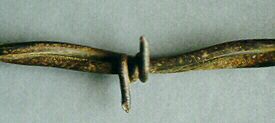
Glidden's 1874 barbed wire design
- 1870s brought first attempts at
large-scale, technology-intensive farming.
- Took advantage of new varieties of wheat (particularly Russian) that could grow as winter wheat in cold climates.
- Dry farming techniques--planting in deep furrows (dust mulch).
- Experiments by people such as Oliver Dalrymple in mid to late 1870s--Grandin Bonanza, a farm of 61,000 acres worked by 200 pairs of harrows, 155 binders, 16 threshers, combines pulled by teams of 30-50 horses and mules or by steam tractors. But many large farms went bankrupt in the droughts of 1885-1890.
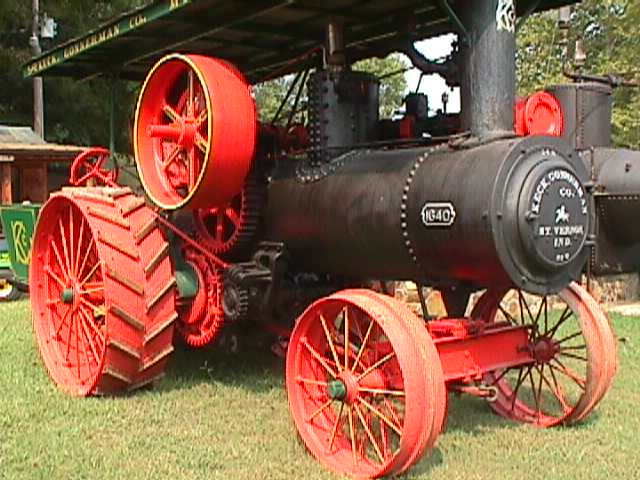
PEM Photo, Steam Tractor, Dacusville Farm Days
- By 1900 5000 steam tractors made per year.
- Required many men to operate and much carrying of supplies, not to mention danger of setting fields on fire with sparks from the engine.
- Mass production of gasoline powered tractors began in 1903.
Back to the history of Mass Production
Historical steps:
- The factory system
- The American System of Manufacture
- The Assembly Line and Scientific Management
- Automation
- flexible production, just-in-time, mass customization , and other trends away from traditional mass production
Where the assembly line wasn't possible, factory owners used Scientific management :
- Frederick Winslow Taylor --proper Philadelphian who went to work for a machine shop with the idea of working his way to the top.
- he was appalled by how inefficient the workers were and set out to rationalize them.
- In 1895 he introduced the differential piece rate--you got a lower rate if you worked slower.
- Taylor wanted not just to reward the worker but to tell him how to do the job--time studies. Also introduced high speed tool steel and patented improved metal cutting machines.
- Frank B. Gilbreth , who joined Taylor in 1907, extended this to motion study--watching how the worker moved and showing him how to eliminate waste motion
- his partner and wife, Lillian Gilbreth , realized that worker resistance was still a key issue and pioneered industrial psychology (they also had 12 children and raised them efficiently, as chronicled in the book and the 1950 film Cheaper by the Dozen)
- Scientific management was applied to skilled workers, not just workers on assembly lines
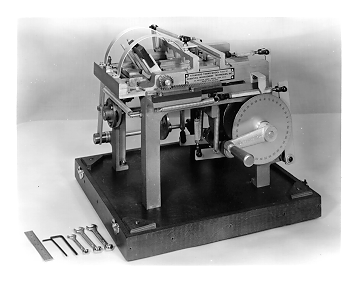
a machine used today in evaluation of workers
How did workers feel about all this?
- Ford's workers were initially not happy with the assembly line initially--turnover reached 380%
- Starting in 1914 Ford paid twice the going wage, and found people eager to work under those terms
- Taylor thought his system would help workers, but they hated the lack of control, and in some cases went out on strike against time study (such political agitation that in 1915 Congress outlawed Taylorism at government arsenals)
- skilled workers were loosing their
position to unskilled workers with machines:
- Cowan gives the example of carpenters using factory-made components
- new office machines revolutionized the office work force--in 1870 men made up 97.5% of the clerical labor force. But typewriting became a women's job . By 1890 women were 21% of clerical labor force, by 1920 50%. Some even argued that women were better with machines than men.

- Pride in work (my list is based on Cowan
p. 187):
- relatively high wages
- work that is not mind-numbingly repetitive
- some control over daily schedule
- some control over quantity and quality of what is produced
- skills that take time to learn are
valued
- some job security because of time it would take to train a replacement
There were other people besides workers who had doubts about the modern, technology-based world:
- World War I showed the dangers of more efficient weapons.
- The conservation movement worried that we would run out of resources.
- some people in the 1920s feared that traditional values were being lost, which is why the first major protests over the teaching of Darwin happened then (see Scopes Monkey Trial )
- The Great Depression of the 1930s made those doubts a lot more common, because a lot of the problem was overproduction.
Consider also how domestic work was changing:
Is technology liberating?
- That may not depend on the technology, but rather on how society's values affect how it is put to use
- I don't mean to imply that technology is value-free, but household technology is an example of a general area of development that could have been liberating but instead was used to reinforce existing values
- this analysis of household technology is valid only for middle-class American women--lower class women have had neither the technology to help them with their housework nor the choice of whether to work outside the home or not
- Starting in the second half of the 19th century, the technology used by the average middle-class housewife has changed dramatically.

cast iron range
1900s Westinghouse
electric range
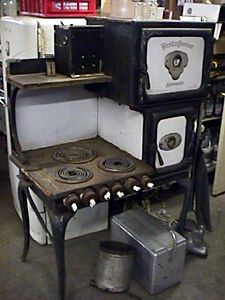
- cast iron range introduced about 1830, universal by the end of the century
- the only appliance in an 1899 model kitchen
- study that same year by Boston School of Housekeeping: in six days required 5 hours 26 minutes of maintenance and took 292 pound of coal
- this shows a clear advantage for the gas or electric range
- a gas or electric range saved hard physical labor and didn't heat up the kitchen
- but electric ranges were sold primarily as modern, as one ad said: "It is so modern, It's so clean, so cool, so efficient."
history of the vacuum cleaner
- lots of non-electric vacuum cleaners were invented in the late 19th and early 20th century--the development of household technology was not simply a result of the availability of electricity
- central vacuum systems had a brief popularity around the turn of the century

- Hoover and similar machines
- the first portable electric vacuum cleaner was introduced in 1907
- advertised in 1910 "Tell your husband you want it for Christmas. He has every convenience for his work: typewriter, adding machine..."
- another 1910 advertisement "doing much of the work of a maid and doing it infinitely better than human hands can do"
Washing clothes
- before mechanization the first task was to carry water. The tools were the washboard and wringer
- initially the process was simply mechanized, with some externally-powered machines introduced in the late 19th century and electric ones coming on the market about 1910
- 1920 electric washing machine ad: "His happiness as well as hers. The man in the house welcomes Bluebird too--and delights in dispelling the gloom of washday. For with Bluebird comes happiness--the happiness of a well-ordered household plentifully supplies with clean clothes." (note rising standards)
- by 1940 washing machines were affordable and widespread, but they still weren't automatic--the top-loading automatic washing machine was only introduced in 1947
- heating irons on the stove was another unpleasant task in the summer

- electric irons were introduced in the 1890s and were appreciated as a big improvement--some utilities gave them away free to promote use of electricity (sort of like cell phones today)
the electric iron
- in the days before permanent press clothing ironing was such a burden that ordinary families actually bought large ironers
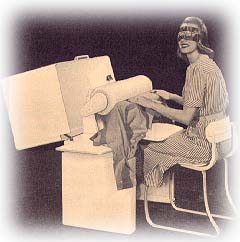
ironer
the story of the refrigerator is fascinating from the technical point of view
-
 GE Monitor on top
Refrigerator, 1928
GE Monitor on top
Refrigerator, 1928 - ice was delivered to homes in cities and towns, so iceboxes were fairly satisfactory
- refrigerators were introduced in the 1910s, but did not catch on until the late 1920s
- when GE decided to introduce an electric refrigerator they carefully selected the technology that cost less to build, required more maintenance, and used more electricity.
- The statistics are certainly not exact, but the evidence we have shows that the amount of time spent on housework by women not employed outside the home has not decreased with the introduction of household technology
| 1928 | Oregon town wives | 63.4 |
| 1928 | farm wives | 61 |
| Post WWII | farm | 60.6 |
| Post WWII | small city | 70.4 |
| Post WWII | large city | 80.6 |
- or, defining housework somewhat
differently:
- 1924-28: farm wives 51 hours/week
- 1965-66 non-employed urban wives 55 hour/week
- today
- rising standards: changing clothes every day instead of once a week, discovery of germ theory of disease in late 19th century
- household technology replaced servants--paid servants 99 per 1000 population in 1900, 58 per 1000 population in l920
- work expands to fill the time available. A new ideology of housework was developed to keep housework a full-time job despite machines that made it easier
- home economics : housework is a job worthy of an intelligent woman (scientific management, Lillian Gilbreth, efficiency, rationalization)
Conclusion
- Technology can be used to reinforce
existing values or to change them
household technology for many years did not liberate women - When we choose our technology for what it can do for us, what goals do we choose and who does the choosing?
Key sources:
Vanek, Joann, "Time Spent in Housework", Scientific American, 231, 5, November 1974, pages 116-120.
Ruth Schwartz Cowan, More Work for Mother: The Ironies of Household Technology from the Open Hearth to the Microwave (New York: Basic Books, 1985).
Skyscrapers and urbanization:
when a great fire burned central Chicago in 1871, people realized the city would need to be rebuilt in a more fire-proof way
this led Chicago to become the first city to start to build taller and taller
Several technologies were needed to make this possible:
Eiffel Tower 
Steel Frame:
- the earliest taller buildings had load-bearing stone walls, but the taller the building the thicker the stone wall needs to be at the bottom
- the Eiffel Tower shows the pure steel frame--picture
to right
- Steel frame construction developed about 1890 for the skyscrapers of Chicago. First steel frame was 1885 for a 9 story building, then 1892 for 21 stories
- the workers who built these frames were in many cases
Mohawk Indians because they had little fear of heights
- concrete pillars that extended down to bedrock
- or steel piles (vertical beams) are forced into the
ground by a pile
driver
- people won't accept tall buildings without a safe way
to get up and down
- the hydraulic elevator was the first practical technology, later replaced by electric elevators
- Elisha
Graves
Otis invented a reliable elevator safety brake,
making the elevator practical for passengers
- escalators didn't catch on until the 1930s, but think of what it meant to people to have a moving stairway--we no longer had to do the work ourselves
- Leiter Building--early steel frame construction
- many of the early skyscrapers still had traditional decorations on the outside
- when a 26 story building was build in Manhattan many said that the maximum height had been attained, but 1912 a 55 story building was built and in 1932 the Empire State Building was 86 stories. The World Trade Center was 110 stories--more than 1/4 mile.
- skyscraper economics in New York
Between 1870 and 1920 New York City expanded from less than a million to 5 1/2 million population and from 22 to almost 300 square miles. Density also increased in the center city with the invention of the elevator and steel frame construction. People began to imagine how far the skyscraper might go
King Gillette, who started the first company to make disposable razor blades, also wrote a book about how the United States should be organized:
- forget capitalism, which is full of wasteful competition, and plan everything out rationally
- cooperation should be the basis of society,
selfishness would be eliminated
- everyone would live in one gigantic city and eat in common dining halls--think how inefficient single family homes are
- if this seems ridiculous consider the proposal that the best thing we could do for the environment would be to all live in cities, and let the rest of the land go back to wilderness
- pictures of future cities usually showed many levels
of highways or walkways connecting the buildings
- an architectural movement called futurism
sought to reject the ideas of the past and embrace
technology
- The Jetson's cartoon is a classic example
- For performance credit watch either H. G. Wells,
"Things to Come," or Fritz Lang's "Metropolis" and write
about how the film you watched expresses modernist ideas
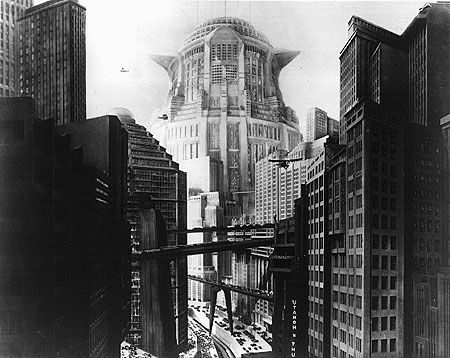
the city in the 1927 film Metropolis
- the movie "Metropolis,"
set
in the year 2026, showed that the dream of the
future was ignoring the lower depths--the machines and
workers making the city possible
- H.G. Wells made this point in The
Time Machine and When
the Sleeper Wakes
- the luxurious city in the air is made possible by
people working in horrible conditions below it
- the giant city became a threatening image--think Blade Runner
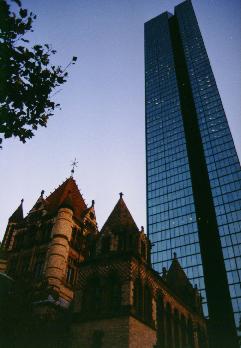 But we did get modern
architecture
But we did get modern
architecture- Modernist architects started to simplify the building
- first they focused on what was functional--instead of decoration, simple functional forms would be a new standard of beauty
- then they started exploring what they could do if
they threw out old assumptions
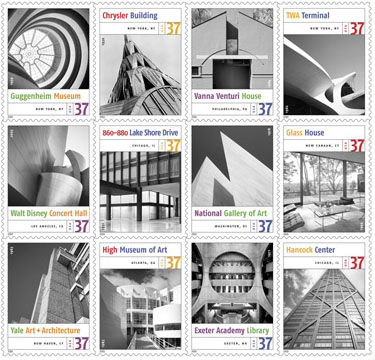
This page written and copyright
Pamela E. Mack
